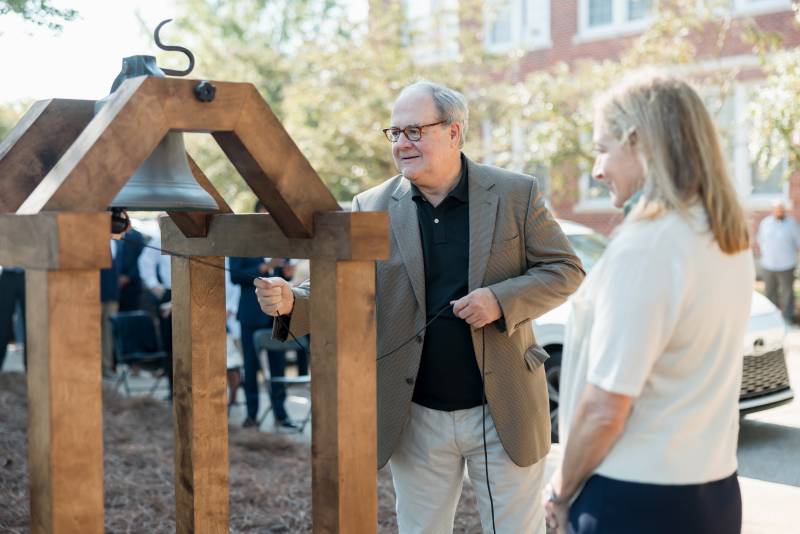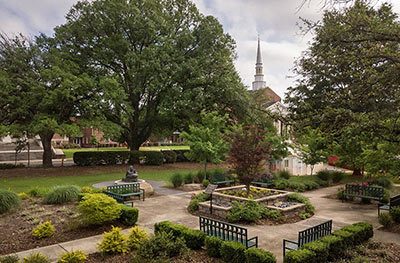Historic Hillman Bell opens MC’s bicentennial session

For generations, a bell in the belfry high above one of the most prominent buildings at Hillman College in Clinton beckoned students to chapel services, hurried late arrivals to class and called the campus to meals in the dining hall.
On Monday, Aug. 11, more than eight decades after it was last used at the women’s college, the Hillman Bell rang once again to call attendees to the start of Mississippi College’s 200th academic session.
At precisely 9 a.m., an hour before MC’s Convocation in Nelson Hall, a representative sample of about two dozen MC family members, including MC president Blake Thompson, ushered in the milestone year by ringing the Hillman Bell 200 times.
Dr. David Miller, MC professor of English and philosophy and faculty graduation marshal on the institutional Bicentennial Working Group, said the Hillman Bell’s inclusion in Convocation is important because it acknowledges the historic coeducational experience at Mississippi College.
“Even before MC absorbed Hillman College, it was the first institution of higher learning to grant degrees to women,” Miller said. “In a couple of situations, women from Hillman – daughters of faculty members who were present at the University – would matriculate at Mississippi College.
“We want to acknowledge and embrace that part of the history of MC. The Bicentennial Steering Committee decided to use the bell similarly to how it had been used at Hillman – to call the college together.”
Established in 1853 by the Central Baptist Association as the Central Female Institute, a “sister” institution to the all-male Mississippi College, the Institute was renamed in 1891 to Hillman College after Walter Hillman, who served as president of the school from 1855 to 1887 (and concurrently president of MC from 1867 to 1873).
Hillman College played a significant role in the community, offering primary, secondary and two-year college programs and focusing on higher education for women. The college shared leadership and many of its professors with MC, which acquired Hillman in 1942 and immediately returned to its coeducational roots.
The Hillman Bell’s precise origin has been lost to time: it bears no foundry mark. But the 63-and-a-half-pound bell was carefully maintained and preserved by the family of Mark Perrin Lowrey Berry, the last president of Hillman College, and recently donated to MC by Jackson resident John Cox and his sister, Carol Heidelberg, Berry’s great-grandchildren.
For Cox, the Hillman Bell represents not only the grand educational institution whose roots date to before the Civil War, but also the memories of his beloved family.
“When I was 6 or 7, my father appeared at our house with this bell and said it had been (Mark Perrin Lowrey Berry’s) and they would ring it at Hillman College,” Cox said. “He hung it up in our backyard and my parents would ring it to call us in from playing in the neighborhood.”
Upon his father’s death last fall, Cox contacted MC officials to inquire about donating the Hillman Bell to the University.
“I thought it would be an important piece to continue the legacy of Mark Perrin Lowrey Berry and his love for the education of women,” said Cox, whose grandmother, Edwina Berry Cox, was a Hillman alum. “It maintains the heritage, not only of Mississippi College, but of my ancestors, and it was important to me to see this legacy of my family preserved.”
Jim Turcotte, vice president, special assistant to the president and co-chair of MC’s Bicentennial Committee, said the timing of Cox’s donation could not have been better.
“We are very grateful to John Cox and his family for donating the Hillman Bell to the college,” said Turcotte, a Clinton native who, as a boy, recalls seeing the buildings of Hillman College, which were located on the present-day site of Lions Club Park in Clinton. “This is a part of our history that will be enjoyed by generations of Mississippi College friends and alumni.
“The timing of this is beyond us. This is something I feel the Lord Himself ordained, and it’s exciting.”
The bell, which now resides on a striking portable stand constructed by Roger Wigley and Mark Roberts, master carpenters in MC’s Campus Operations department, was situated on the MC Quad near Nelson Hall for Convocation. The bell’s sound rang loud and true; in fact, Turcotte created a handmade leather muffle to dampen its peal and provide a pleasant sound to listeners.
Following Convocation, the Hillman Bell will be included among the artifacts in the University’s bicentennial exhibition and in future bicentennial events. It will have a permanent home in the University’s archives.
Miller said the Hillman Bell may also be incorporated into other campus ceremonies like Commencement, where it would harken to the University’s past while summoning MC graduates of the future.
“The story of Hillman College is part of a greater story of women’s education in the 19th century,” Miller said. “That story is important because it’s the history of an increasing acknowledgment that women and men, together, have a God-given capacity for education. Even in the 19th century, when the larger culture was having this debate about women, there was Hillman.
“These two institutions – Mississippi College and Hillman College – stood side-by-side, hand-in-hand, in this community. The bell is a touchstone, part of the Hillman experience and part of the MC experience. It represents who we are.”
Sign-up For Our Newsletter
Get the latest news about Mississippi College delivered right to your inbox by subscribing to the Along College Street e-newsletter.


